2. 黄河流域内蒙段水资源与水环境综合治理协同创新中心, 呼和浩特 010018
2. Collaborative Innovation Center for Integrated Management of Water Resources and Water Environment in the Inner Mongolia Reaches of the Yellow River, Hohhot 010018, China
草地是“山水林田湖草”有机系统的重要组成部分, 全球草地将近35亿hm2, 占陆地面积的26%左右[1~3].草地不仅是初级生产力的重要来源, 在区域水土保持、维持生物多样性以及调节区域生态平衡等方面均具有极其重要的作用, 是陆地生态系统的关键组成部分[4, 5].特别地, 牧草根系主要发育的0~60 cm土壤是碳(C)、氮(N)和磷(P)等营养元素固持的关键土层[6, 7], 该层既受到大气降水和放牧状况等外界环境条件变化的明显影响, 也是维系整个草地生态系统多样性及生态功能稳定的关键层[8~10].
细菌既是土壤生物多样性的重要组成部分, 也是土壤元素代谢循环的关键参与者[11~13].目前, 关于不同介质中细菌群落的分析, 如水体、土壤和沉积物等, 特别是在生长季草地微生物群落结构特征分析方面, 已经取得了丰硕的研究成果.如Zhou等[14]分析了不同温带草地微生物群落结构生态功能在降水梯度下的变化特征, Liu等[15]分析了N元素固持效率等对细菌等微生物群落结构的影响, Chen等[16]则分析了内蒙古高原草地土壤N、P和C元素与微生物结构、气候变化等综合因素间的相互关系.不过, 虽然如Jia等[17]分析了降雪过程变化对内蒙古非生长季草地微生态系统对N元素固持效率的影响, 但是整体上对于内蒙古非生长季草地土壤中细菌群落多样性垂向结构及生态功能特征对比研究成果却并不多见, 这显然不利于理解典型区域草原生态多样性, 也不利于分析寒旱区非生长季草地土壤微生态环境的空间变化过程.
乌梁素海是中国西北部最大的内陆湖泊, 其东部流域主要分布在内蒙古自治区巴彦淖尔市和包头市境内, 面积近5 000 km2, 属干旱半干旱气候区, 区域昼夜温差较大, 夏季时短, 冬季时长且寒冷.年均气温为6.6℃, 在生长季7月气温最高, 年均超过25℃, 而非生长季1月平均气温最低, 年均低于-10℃; 多年平均降水量为215 mm ·a-1, 且主要集中在夏季, 年均蒸发量可达到1 300 mm ·a-1.乌梁素海流域地形主要以山地为主, 约占60%, 其余部分则主要为山前倾斜平原, 分布面积较广的荒漠草原生态单元[18, 19].不过, 伴随人类活动的增加, 如农业开垦和放牧活动等, 对草地生态健康和草地土壤生物多样性维持产生影响, 甚至改变了草地基本生态结构[20, 21].
因此, 在“一湖两海”和黄河流域生态保护背景下, 选取内蒙古乌梁素海东部流域草地生态区作为研究目标(图 1), 在非生长季(9月至来年4月)末的5月初, 分别采集30 cm和60 cm深度处土壤样品, 利用Illumina MiSeq二代测序方法, 对不同深度样品中细菌群落组成和优势细菌门、属结构的变化特征进行对比分析, 进而讨论了草地土壤中细菌群落的生态功能相对丰度随深度变化情况, 以期为详细研究内蒙古草地微生态系统的生物多样性及群落结构差异提供理论参考.
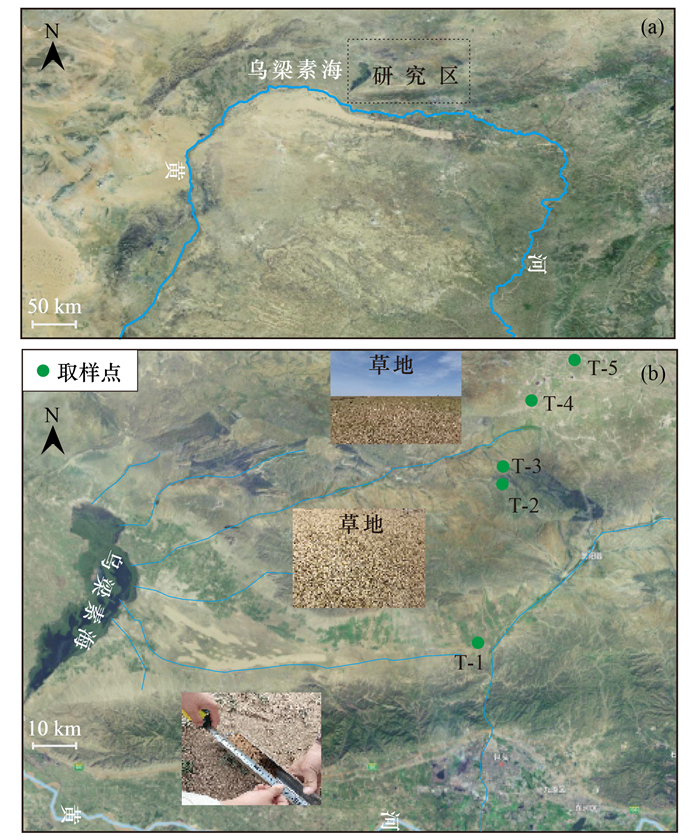
|
(a)研究区位置示意; (b)取样点(T-1、T-2、T-3、T-4和T-5)位置示意 图 1 研究区概况和取样点位置示意 Fig. 1 Study area and sample locations |
为了减少生长季放牧过程中人为因素及地表风化等因素影响, 于2021年5月上旬非生长季末在内蒙古乌梁素海东部流域达尔罕茂明安联合旗等区域开展了草地土壤样品采集工作.根据研究区实际的地形地貌特征, 共采集5个取样点的土壤样品, 命名为T-1、T-2、T-3、T-4和T-5, 共获得样品10个, 其中30 cm深度样品5个, 60 cm深度样品5个[图 1(b)].所有样品采集完成后, 选取适量置于无菌离心管中, 并立即保存在液氮罐中, 用于后续实验分析.
1.2 DNA提取与PCR扩增按照FastDNA® Spin Kit试剂盒(该试剂盒适用水和土壤等样品)说明逐步提取基因组总DNA[22].DNA产物利用16S rRNA对V4-V5区扩增引物进行PCR扩增, 引物选择515F(5′-GTGCCAGCMGCCG CGGTAA-3′)-806R(5′-GGACTACVSGGGTATCT AAT-3′).修饰后的通用引物含有不同的Tag标签用于区别样品.PCR扩增体系为20 μL, PCR扩增的反应条件为:94℃, 5 min; 30×(94℃, 30 s; 54℃, 30 s; 72℃, 45 s); 10 min(具体扩增过程可参考文献[22]).最后, 利用上海美吉生物医药科技有限公司MiSeq PE300测序仪(Illumina Inc.San Diego.CA.USA)完成序列测定.
1.3 测试数据处理在测试数据处理过程中, 首先对原始数据进行拼接、去杂质及非特异性片段, 然后基于有效数据进行OTU(operational taxonomic unit)聚类和物种分类分析, 将具有≥97%相似性的序列分配给相同的OTU[23]. 选取每类中最长的序列为代表序列, 在QIIME平台中调用Blast方法对序列数据库进行比对, 获得每个OTU表示序列的分类学信息.总体上, 本次实验全部10个样品均获得有效数据, 有效序列的平均长度为253 bp.
利用Mothur(版本1.30.2)指数分析软件计算样品Sobs(Sobs:the observed richnes)等α多样性指数; 利用R语言工具(如Uparse平台, 版本11; RDP Classifier平台, 版本2.13; Usearch平台, 版本11)进行OTU统计; 利用Vegan软件包(如Version, 版本3.3.1)对土样中细菌群落结构进行分析统计; 利用PICRUSt2软件包(版本2.2.0)对KEGG(Kyoto Encyclopedia of Genes and Genomes, 京都基因和基因组百科全书, http://www.genome.jp/kegg/)代谢通路中第二、第三代谢层级和群落生态功能进行预测分析; 利用了Networkx软件包(版本2.1)分析样品间的空间共现性[24].
2 结果与分析 2.1 细菌群落结构变化基于Sobs指标(表示实际测试到的OTU数目)构建了稀释曲线, 结果显示不同深度样品在1万条测试序列数后变化趋势均逐渐平缓, 显示测序数据基本可以反映各个样品内的物种信息情况[25].同时, 30 cm深度样品稀释曲线的样品间分散程度明显比60 cm样品大[图 2(a)].根据原始测试OTU数据的抽平结果统计, 30 cm深度样品中OTU个数较多, 共有5 238个OTUs, 而60 cm深度样品中OTU个数较少, 共有4 862个OTUs, 两者共享3 662个OTUs, 占到总数的56%以上[图 2(b)]. (a)基于Sobs指数的稀释曲线; (b)OTU水平上的Venn图; (c)和(d)PCoA分析

|
(a)基于Sobs指数的稀释曲线; (b)OTU水平上的Venn图; (c)和(d)PCoA分析 图 2 稀释曲线, Venn图和PCoA分析 Fig. 2 Dilution curve, Venn diagram, and PCoA analysis results |
再者, 基于PCoA分析结果, 可以发现各取样点土壤中细菌群落结构受取样点地理位置的影响较明显, 且不同深度样品间也存在一定程度的差异[图 2(c)], 即30 cm深度样品的离散程度略高于60 cm[图 2(a)和2(d)].
整体上, 非生长季里, 虽然不同深度土样中细菌群落多样性的差异不大, 但是上部即30 cm处样品中OTU的丰富度要略高于60 cm处样品中OTU的丰富度, 样品的离散程度也相对明显.显然, 深度差异对细菌群落结构产生了一定程度的影响.
2.2 优势细菌门类变化差异在分析不同深度样品细菌群落结构特征的基础上, 在门、属和OTU水平对30 cm和60 cm深度样品中的优势细菌群落结构进行了对比, 并对细菌群落的构成特征及相对丰度变化空间差异进行了分析(图 3).整体上, 尽管受到空间地理位置等因素的影响, 不同取样点样品的细菌群落结构存在一定程度的空间差异, 但各取样点上优势细菌门类的组成基本一致, 平均相对丰度排在前15位的菌属及OTUs类型也基本一致.不过, 随着深度变化, 样品中优势菌门、菌属和OTUs的相对丰度占比却出现逐渐明显的差异.

|
图 3 不同分类水平上优势细菌相对丰度占比的垂向特征 Fig. 3 Characteristics of bacterioplankton community at phylum, genus, and OTU levels |
在门水平上, 放线菌(Actinobacteriota)、变形菌(Proteobacteria)、绿弯菌门(Chloroflexi)、酸杆菌门(Acidobacteriota)、芽单胞菌门(Gemmatimonadota)、浮游菌门(Planctomycetota)、Methylomirabilota和Crenarchacota等8个细菌门类的相对丰度占比均超过1%, 且均存在于30 cm和60 cm样品中(图 3).此外, 30 cm样品中拟杆菌(Firmicutes)、粘球菌(Myxococcota)以及GAL15的相对丰度占比超过1%; 而60 cm土样中, 疣微菌(Verrucomicrobiota)和unclaassified _k_norank_d_bacteria的相对丰度占比也超过了1%(图 4).比较来看, 在30~60 cm, 以GAL15、Verrucomicrobiota和Firmicutes等为主的7个优势细菌门类的相对丰度占比的变化幅度较为明显(如以30 cm样品相对丰度为基准).相对地, Crenarchaeota相对丰度占比的变异幅度最小(图 4).
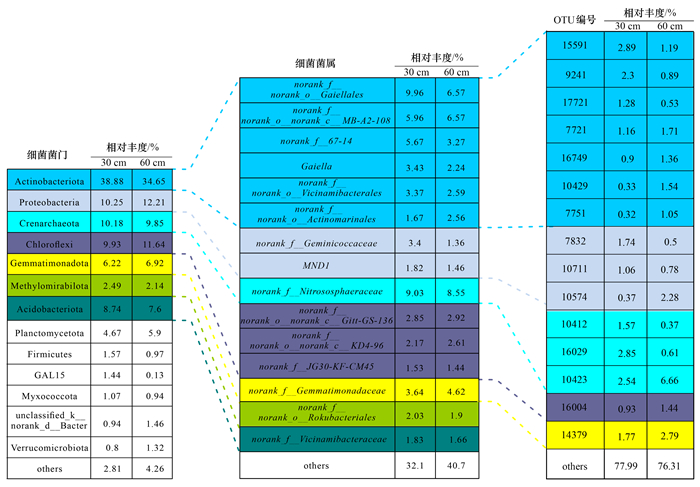
|
相同的颜色表示属于同一细菌门类 图 4 优势细菌门、属和OTUs等的相对丰度占比在30 cm和60 cm样品间差异 Fig. 4 Relative abundance changes in dominant phyla, genera, and OTUs between 30 cm and 60 cm |
在菌属及OTU水平上, 相对丰度占比前15位的菌属和OTUs在30 cm和60 cm样品间的差异则更加明显.其中, norank_ f_ _ 67-14 (属于Actinobacteriota门)和norank_ f_ _ Geminicoccaceae(属于Proteobacteria门)相对减少幅度最大, 而norank_ f_ _ Gemmatimonadaceae(属于Gemmatimonadota门)和norank_ f_ _norank_o_ _Actinomarinales(属于Actinobacteriota门)的相对增加幅度最大(图 4); 相对地, OTU10574(属于Proteobacteria门Pseudomonas属)和OTU10423(属于Actinobacteriota门norank_ f_ _norank_o_ _Gaiellales属)的相对增加幅度最大, 而OTU16029和OTU10412(均属于Crenarchaeota门norank_ f_ _Nitrososphaeraceae属)的相对减少幅度最大(图 4).
整体上, 相对丰度占比前15位的OTUs, 分别属于5个菌门; 相对丰度占比前15位的菌属则属于7个菌门.其中, 60 cm样品中相对丰度占比高于30 cm样品的优势细菌门类有6个, 优势菌属有5个, 而OTU则为8个.显然, 不同深度土壤中的细菌群落结构的确存在一定程度的差异, 即使同一细菌门类, 所含菌属或OTU相对丰度占比变化情况也存在差异.
2.3 细菌群落垂向结构差异在细菌门类差异分析的基础上, 利用空间共现性网络分析, 在菌属及OTU水平上, 对30 cm和60 cm深度土样中细菌群落结构差异进行了对比.其中, 网络分析以5个取样点物种相对丰度值求和计算得出, 以相对丰度值≥500为基准进行空间共现性网络分析.
网络共现性分析结果显示, 30 cm样品中独有OTU个数为63个, 占全部OTU数量的39.87%, 而60 cm样品中独有OTU个数为36个, 占全部OTU数量的22.78%.相对应地, 在两类样品中都出现的OTU数量为59个, 占比约为37.34%[图 5(a)].显然, 在不同深度的样品中, OTU占比情况说明两类样品间物种组成既存在密切的联系, 又各具特征.
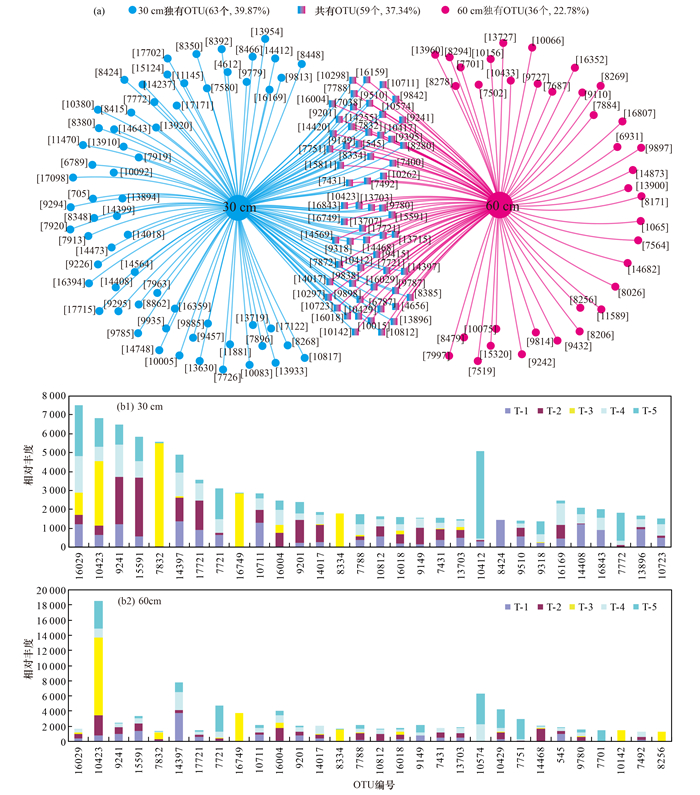
|
(a)OTU水平上30 cm和60 cm土壤中细菌群落结构的网络共现性, 如“[13954]”等其括号内数字表示OTU编号, 括号无意义; (b1)30 cm和(b2)60 cm显示土壤中相对丰度值前30位的OTUs空间差异 图 5 共现性网络分析及优势OTUs相对丰度值的空间差异 Fig. 5 Co-occurrence network analysis and spatial difference of abundance of dominant OTUs |
在相对丰度值排在前30位的OTUs中(如果以相对丰度≥500为依据, 则涉及约100个OTUs, 如图 5(a)所示, 因此这里仅选择相对丰度值(求和)排在前30位的OTUs进行差异分析), 在30 cm和60 cm样品中均出现的OTUs有20个[图 5(b)].虽然多数OTUs为两者共有, 但是不同OTU在不同深度样品中的相对丰度差异明显.例如, OTU10423(属于norank_ f_ _Nitrososphaeraceae属)作为Crenarchacota门的重要组成部分, 其在30 cm样品中的相对丰度值总和为6 830, 但在60 cm样品中相对丰度值总和则突然增加到18 492, 成为相对丰度最高的OTU.相对地, 在30 cm样品中, OTU16029(属于norank_ f_ _ Nitrososphaeraceae属)的相对丰度值最高.另外, OTU10412 (属于norank_ f_ _ Nitrososphaeraceae属)在30 cm样品中的相对丰度值最高[图 5(b1)], 而OTU10574(属于Pseudomonas属)在60 cm样品中的相对丰度最高[图 5(b2)].由于取样点地理位置的差异, 不同OTUs的相对丰度表现出了空间差异.
当然, 通过相对丰度前30位OTUs的样品间差异比较, 初步显示了不同深度样品生物群落垂向间的差异.在此, 为了进一步分析这种差异性的生态群落意义, 对不同优势菌门、菌属在生态群落中的贡献程度进行了再次分析(图 6).
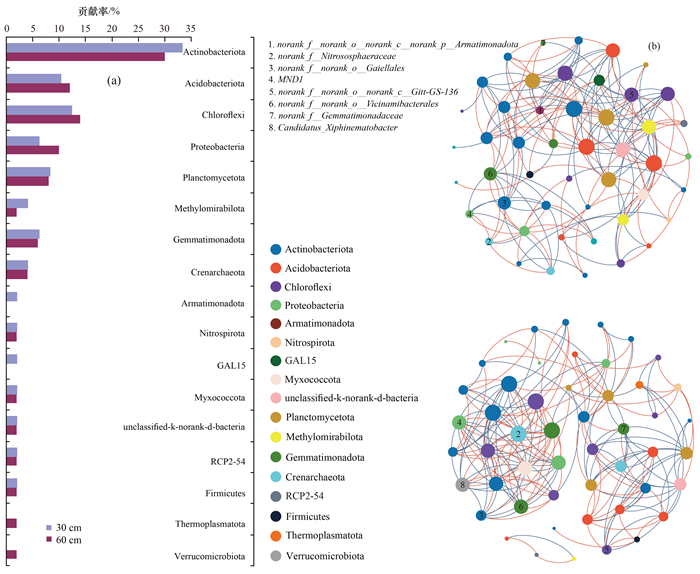
|
(a)30 cm和60 cm样品中细菌群落结构贡献率门类水平上对比; (b)30 cm和60 cm样品中细菌群落结构网络 图 6 不同深度样品中细菌网络相关性及细菌群落差异分析 Fig. 6 Vertical difference of bacterial network correlation and bacterial community |
在门类水平上, Actinobacteriota的结构贡献度最高, 且在30 cm样品中的结构贡献率略高于60 cm样品, 显示Actinobacteriota在草地细菌群落结构稳定性方面起着重要作用.对于其他菌门, 如Acidobacteriota、Chloroflexi和Proteobacteria等, 在60 cm样品中的结构贡献率略高.特别地, Thermoplasmatota和Verrucomicrobiota在30 cm样品中的贡献率为0, 而Armatimonadota和GAL15在60 cm样品中的贡献率为0[图 6(a)].
进一步, 分别选取Crenarchacota、Actinobacteriota、Proteobacteria和Chloroflexi等8个优势细菌门类中的norank_ f_ _Nitrososphaeraceae、norank_ f_ _norank_o_ _Gaiellales、norank_ f_ _Geminicoccaceae、norank_ f_ _norank_o_ _norank_c_ _Gitt-GS- 136和Candidatus_Xiphinematobacter等8个菌属的生态结构贡献率变化作对比分析[图 6(b)], 结果显示在属水平上, 不同深度样品细菌群落结构中优势菌属的贡献程度变化与所属菌门群落结构贡献率以及相对丰度值的变化趋势并不完全一致:如norank_ f_ _norank_o_ _norank_c_ _norank_p_ _ Armatimonadota和Candidatus_Xiphinematobacter分别在30 cm和60 cm样品中存在明显的群落结构贡献, 既显示了两个菌属在不同深度样品中的生态结构稳定的独特重要性[图 6(b)], 又对应了Armatimonadota和Verrucomicrobiota门在群落结构中贡献度的变化特征[图 6(a)].再者, 虽然Crenarchacota在生态结构中的贡献度随着深度的增加变化不大, 但是norank_ f_ _Nitrososphaeraceae的贡献度随着深度的增加则出现较为明显的升高, 对应了60 cm样品中OTU10423相对丰度占比明显增加(图 4); 相对地, 虽然Proteobacteria门在60 cm样品中的生态结构贡献度明显较高, 但是如归属于 NMD1属的OTU10711在30 cm样品中的相对丰度值却明显高于60 cm样品中的相对丰度值[图 5和图 6(b)].
显然, 在草地土壤中, 不同深度样品中构成细菌群落结构的优势菌门、菌属乃至OTUs的相对丰度与其在细菌群落结构网络中的贡献性高低并没有一一对应.根据分析结果, 初步推断源于Armatimonadota和Verrucomicrobiota门的norank_ f_ _norank_o_ _norank_ c_ _norank_ p_ _Armatimonadota和Candidatus_Xiphinematobacter可以分别作为30 cm和60 cm样品细菌群落生态结构中的典型菌属, 开展进一步生态学研究.
2.4 细菌群落生态功能分析PICRUSt2是针对16S扩增子测序结果进行功能预测的一款升级软件包(软件具体介绍以及功能分析方法见文献[26~28]).基于不同细菌门类往往具有不同的功能特性, 在此, 主要分析了30 cm和60 cm草地土壤中细菌群落功能类型的丰度变化差异.
基于KEGG代谢通路分析, 得到草地土壤pathway level 3功能共对应403个kos(功能编号), 分别属于46类pathway level 2功能, 6类pathway level 1功能.其中, 涉及到“carbon”关键词的功能共有7个, 其中ko01200(carbon metabolism)的丰度值最高; 涉及到“nitrogen”关键词的功能出现1个, 即ko00910(nitrogen metabolism); 涉及“phosph”关键词的功能有9个, 其中ko00190(oxidative phosphorylation)的丰度值最高.整体上, 30 cm样品中共有269个pathway level 3功能的相对丰度低于60 cm样品, 而ko00190、ko00910和ko01200的相对丰度则均是在60 cm样品中较高.
进一步, 根据pathway level 3功能中ko相对丰度大小, 对相对丰度位于前100位的功能进行了对比分析(图 7).结果显示, 相对丰度排在前100位的level 3功能分别属于: 局概览图(global and overview maps)、核苷酸代谢(nucleotide metabolism)、能量代谢(energy metabolism)、碳水化合物代谢(carbohydrate metabolism)、氨基酸代谢(amino acid metabolism)、辅助因子和维生素代谢(metabolism of cofactors and vitamins)、其他氨基酸的代谢(metabolism of other amino acids)、萜类和聚酮类代谢(metabolism of terpenoids and polyketides)、脂质代谢(lipid metabolism)、其他次级代谢产物的生物合成(biosynthesis of other secondary metabolites)、异种生物降解和代谢(xenobiotics biodegradation and metabolism)、聚糖生物合成和代谢(glycan biosynthesis and metabolism)、复制和修复(replication and repair)、折叠, 分类和降解(folding, sorting and degradation)、翻译(translation)、膜输送(membrane transport)、信号转导(signal transduction)、细胞群落原核生物(cellular community-prokaryotes)、细胞能动性(cell motility)、细胞衰老和死亡(cell growth and death)、运输和分解代谢(transport and catabolism)、内分泌系统(endocrine system)、年龄(aging)、抗药性抗菌剂(drug resistance-antimicrobial)、细菌性传染病(infectious disease-bacterial)和癌症概述(cancer-overview)等26个level 2功能类别.主要地, 代谢功能(metabolism)共有12类, 分别占整体功能丰度的82.22%(30 cm)和82.12%(60 cm); 遗传信息处理(genetic information processing)共有3类, 分别占整体功能丰度的7.22%(30 cm)和7.36%(60 cm); 环境信息处理(environmental information processing)共有2类, 分别占整体功能丰度的4.77%(30 cm)和4.81%(60 cm); 细胞过程(cellular processes)共有4类, 分别占整体功能丰度的4.14%(30 cm)和4.08%(60 cm).其他功能丰度占比未超过1%, 不再叙述.

|
图 7 Pathway level3功能中相对丰度前100位ko变化 Fig. 7 Changes in relative abundance of the top 100 ko in the pathway level3 |
整体上, 草地土样中细菌群落结构的代谢功能丰度最高, 且明显高于其他功能的相对丰度, 显示草地土壤细菌群落结构的生态功能以代谢功能为主.虽然30 cm样品中代谢功能相对丰度整体略高于60 cm样品, 但是与C、N和P代谢有关的ko00190、ko00910和ko01200, 其相对丰度均表现出60 cm样品中相对丰度略高的特征.当然, 个别代谢功能类别, 如ko00400和ko00540的相对丰度同样在60 cm样品中较高.
3 讨论草地土壤中微生物, 特别是细菌及古菌, 是草地生态系统维持稳定发展的关键组成部分之一, 也是土壤有机质分解、元素迁移和转换等过程的重要参与者[29~31].放牧制度差异和大气降水、温度变化等气象因子的改变往往对草地土壤中的细菌群落等产生不同程度的影响[32]. 当然, 不同细菌生态功能群落对环境因子改变响应过程也存在一定程度的差异, 且草原土壤中C、N和P元素含量变化与微生物群落结构密切相关[33, 34].
首先, 随着深度增加, 草地土壤中优势细菌群落结构发生了一定程度的变化.例如, 作为草地土壤中相对丰度占比最高的优势细菌门类, Actinobacteriota相对丰度占比伴随深度的增加出现了近10%的下降, 而Proteobacteria和Chloroflexi的相对丰度占比则分别出现近17%和19%的增加(图 4), 最终导致在细菌群落结构中, Actinobacteriota的细菌群落结构贡献度在60 cm样品中相对下降, 而Proteobacteria和Chloroflexi的细菌群落结构贡献度在60 cm样品中相对上升.当然, 通过基于菌属及OTU水平上的进一步分析, 可以发现细菌菌属结构的变化在不同深度草地土壤中扮演更为重要的角色, 更能反映草地土壤细菌群落结构随深度变化过程中的关键特征[35].例如, 虽然在60 cm样品中Chloroflexi细菌群落结构贡献度比30 cm样品中有所升高, 且其所含的OTU16004相对丰度由0.93%(30 cm)上升到1.44%(60 cm), 对应所属的norank_ f_ _norank_o_ _norank_c_ _Gitt-GS- 136菌属相对丰度也略有上升(图 4), 但该菌属在60 cm样品中的群落结构贡献度却有所下降(图 6); 再者, OTU16029和OTU10423均属于norank_ f_ _Nitrososphaeraceae属, 但是两者由30 cm样品中的相对丰度占比2.85%和2.54%分别转变为60 cm样品中的0.61%和6.66%(图 4), 出现明显的差异变化.当然, 尽管norank_ f_ _Nitrososphaeraceae属相对丰度随深度变化出现了小幅度下降, 基本对应了Crenarchacota菌门群落结构贡献度的小幅下降, 但是norank_ f_ _ Nitrososphaeraceae在60 cm样品中的群落结构贡献度却有明显提升(图 6). 显然, 草地土壤中部分细菌门类或菌属相对丰度的变化并不是其群落结构贡献率的主要决定性因素, 特别是如norank_ f_ _norank_o_ _ norank_c_ _norank_p_ _Armatimonadota(属于Armatimonadota, 但未分类)和Candidatus_ Xiphinematobacter(属于Verrucomicrobiota, 干旱区草地土壤的优势菌属之一[36])虽然分别是30 cm和60 cm样品中细菌群落结构组成中的关键菌属, 但Armatimonadota和Verrucomicrobiota的相对丰度却并不占据优势, 这一结果也将为在研究区开展不同深度草地土壤中细菌群落结构及其群落稳定性分析提供特征菌属筛选依据, 可以进一步结合不同深度土壤理化指标的具体变化, 如含水率和pH值等[35], 开展相关细菌门类, 特别是未分类关键菌属的生态学研究.
再者, 植物的细菌群落结构与土壤C、N和微生物群落密切相关[37], 有研究报道在草原上植物物种的多样性对土壤微生物的功能和酶具有很大的影响[38].例如, Actinobacteria能促使土壤中的动物和植物遗骸腐烂[39], 而相对丰度及群落结构贡献度随深度增加而下降可能正是对应了无论在封育还是在放牧型草地中C、N和P等元素均出现伴随深度增加相对含量下降的变化趋势[40].而通过代谢通路中不同ko相对丰度的对比, 发现60 cm样品中与C、N和P元素代谢有关的ko00190、ko00910和ko01200功能相对丰度均出现增加(图 7), 这进一步对应了土壤细菌群落生态功能以代谢功能为主的分析结果, 即通过代谢功能丰度的增加进而减少了土壤中C、N和P元素的含量[41, 42](图 8).显然, 由于土壤中细菌群落功能基因的核心和附属成分会对环境因子产生差异响应[43], 这导致细菌群落的丰富度和组成结构存在不同的变化特征, 即伴随深度及外部环境的改变, 土壤中细菌群落功能基因的核心成分和附属成分可能均会发生变化, 但不同功能基因的响应程度不同[44].
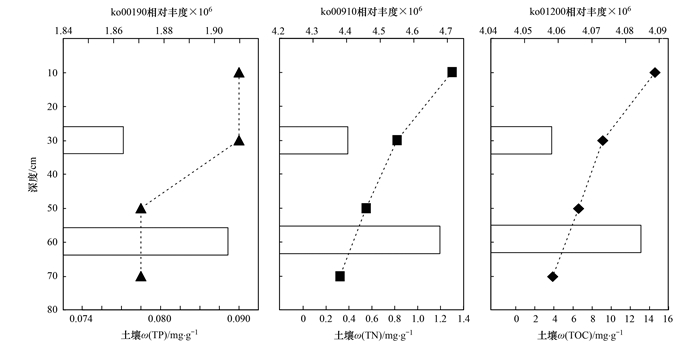
|
TP:总氮, TP:总磷, TOC:总有机碳; TP、TN和TOC含量数据来自文献[42]; 柱状图对应功能相对丰度, 数据点对应含量 图 8 草地土壤中ko00190、ko00910和ko01200功能相对丰度及土壤TP、TN和TOC含量垂向变化 Fig. 8 Vertical changes in relative functional abundances of ko00190, ko00910, and ko01200 and contents of TP, TN, and TOC in grassland soil |
整体上, 虽然分析结果显示不同深度草地土壤中优势细菌门类结构并没有发生明显的改变, 但是菌属和OTU等相对丰度进一步分析结果却逐渐显示了细菌群落结构特征随深度增加出现变化, 并显示不同深度土壤细菌群落结构组成中特有菌门或菌属的贡献率存在差异, 这将为进一步分析草地土壤细菌群落结构和生态功能空间演变提供理论支撑.
4 结论(1) 虽然Actinobacteriota、Proteobacteria、Chloroflexi、Acidobacteriota、Gemmatimonadota、Planctomycetota、Methylomirabilota和Crenarchacota等相对丰度占比均超过1%, 且均存在于30 cm和60 cm样中, 但其中60 cm样中相对丰度高于30 cm样的优势菌门有6个, 优势菌属有5个, OTU则为8个.其中, norank_ f_ _ 67-14 (属于Actinobacteriota)和norank_ f_ _ Geminicoccaceae(属于Proteobacteria)相对丰度占比减少幅度最大, 而norank_ f_ _ Gemmatimonadaceae(属于Proteobacteria)和norank_ f_ _norank_o_ _Actinomarinales(属于Actinobacteriota)相对丰度占比增加幅度最大; 相对地, OTU10574(属于Proteobacteria)和OTU10423(属于Actinobacteriota)相对丰度占比的增加幅度最大, 而OTU16029和OTU10412(属于Crenarchaeota)相对丰度占比的减少幅度最大.
(2) 不同深度样品中构成细菌群落结构的优势菌门、菌属乃至OTUs和细菌群落结构网络贡献性较高的菌门、菌属及OTUs并不是一一对应的.特别地, 来源于Armatimonadota和Verrucomicrobiota的norank_ f_ _norank_o_ _norank_c_ _norank_p_ _Armatimonadota和Candidatus_Xiphinematobacter分别在30 cm和60 cm样品细菌群落结构中具有较高的贡献度.因此, 在对未分类典型菌属开展深入分析的基础上, 上述两个菌属可以作为开展研究区草地土壤中细菌群落结构垂向变化的关键菌属进行生态学分析.
(3) 草地土壤细菌群落结构的生态功能以代谢功能为主, 且相较于30 cm样品, 60 cm样品中与C、N和P元素代谢功能有关的ko00190、ko00910和ko01200等相对丰度均出现增加, 即通过代谢功能丰度的增加减少了深层土壤中C、N和P等典型营养元素的相对含量.
| [1] | 中华人民共和国农业部畜牧兽医司, 全国畜牧兽医总站. 中国草地资源[M]. 北京: 中国科学技术出版社, 1996. |
| [2] |
沈海花, 朱言坤, 赵霞, 等. 中国草地资源的现状分析[J]. 科学通报, 2016, 61(2): 139-154. Shen H H, Zhu Y K, Zhao X, et al. Analysis of current grassland resources in China[J]. Chinese Science Bulletin, 2016, 61(2): 139-154. |
| [3] |
谢高地, 张钇锂, 鲁春霞, 等. 中国自然草地生态系统服务价值[J]. 自然资源学报, 2001, 16(1): 47-53. Xie G D, Zhang Y L, Lu C X, et al. Study on valuation of rangeland ecosystem services of China[J]. Journal of Natural Resources, 2001, 16(1): 47-53. |
| [4] |
方精云, 白永飞, 李凌浩, 等. 我国草原牧区可持续发展的科学基础与实践[J]. 科学通报, 2016, 61(2): 155-164. Fang J Y, Bai Y F, Li L H, et al. Scientific basis and practical ways for sustainable development of China's pasture regions[J]. Chinese Science Bulletin, 2016, 61(2): 155-164. |
| [5] |
刘兴元, 牟月亭. 草地生态系统服务功能及其价值评估研究进展[J]. 草业学报, 2012, 21(6): 286-295. Liu X Y, Mu Y T. Research progress in the ecosystem services function and value of grasslands[J]. Acta Prataculturae Sinica, 2012, 21(6): 286-295. |
| [6] |
苏日娜, 俎佳星, 金花, 等. 内蒙古草地生产力及载畜量变化分析[J]. 生态环境学报, 2017, 26(4): 605-612. Surina, Zu J X, Jin H, et al. Changes in grassland productivity and livestock carrying capacity in Inner Mongolia[J]. Ecology and Environmental Sciences, 2017, 26(4): 605-612. |
| [7] |
王占青, 张杰雪, 杨雪莲, 等. 高寒草甸不同斑块草地土壤微生物多样性特征研究[J]. 草地学报, 2021, 29(9): 1916-1926. Wang Z Q, Zhang J X, Yang X L, et al. Characteristics of soil microbial diversity in different patches of alpine meadow[J]. Acta Agrestia Sinica, 2021, 29(9): 1916-1926. |
| [8] |
张扬建, 朱军涛, 沈若楠, 等. 放牧对草地生态系统影响的研究进展[J]. 植物生态学报, 2020, 44(5): 553-564. Zhang Y J, Zhu J T, Shen R N, et al. Research progress on the effects of grazing on grassland ecosystem[J]. Chinese Journal of Plant Ecology, 2020, 44(5): 553-564. |
| [9] |
于钊, 李奇铮, 王培源, 等. 退化和恢复过程驱动的荒漠草地生态系统有机碳密度变化[J]. 中国沙漠, 2022, 42(2): 215-222. Yu Z, Li Q Z, Wang P Y, et al. Changes of organic carbon density in desert steppe ecosystem driven by degradation and restoration[J]. Journal of Desert Research, 2022, 42(2): 215-222. |
| [10] |
刘啸林, 闫鑫宇, 刘珂彤, 等. 草地生态系统微生物群落对季节性水淹的响应[J]. 河南师范大学学报(自然科学版), 2021, 49(6): 47-54. Liu X L, Yan X Y, Liu K T, et al. Responses of soil microbial community to seasonal flooding in a grassland ecosystem[J]. Journal of Henan Normal University (Natural Science Edition), 2021, 49(6): 47-54. |
| [11] |
孙华方, 李希来, 金立群, 等. 黄河源人工草地土壤微生物多样性对建植年限的响应[J]. 草业学报, 2021, 30(2): 46-58. Sun H F, Li X L, Jin L Q, et al. Change over time in soil microbial diversity of artificial grassland in the Yellow River source zone[J]. Acta Prataculturae Sinica, 2021, 30(2): 46-58. |
| [12] | Takriti M, Wild B, Schnecker J, et al. Soil organic matter quality exerts a stronger control than stoichiometry on microbial substrate use efficiency along a latitudinal transect[J]. Soil Biology and Biochemistry, 2018, 121: 212-220. |
| [13] | Ling N, Chen D M, Guo H, et al. Differential responses of soil bacterial communities to long-term N and P inputs in a semi-arid steppe[J]. Geoderma, 2017, 292: 25-33. |
| [14] | Zhou S T, Xue K, Zhang B, et al. Spatial patterns of microbial nitrogen-cycling gene abundances along a precipitation gradient in various temperate grasslands at a regional scale[J]. Geoderma, 2021, 404. DOI:10.1016/j.geoderma.2021.115236 |
| [15] | Liu W X, Jiang L, Yang S, et al. Critical transition of soil bacterial diversity and composition triggered by nitrogen enrichment[J]. Ecology, 2020, 101(8). DOI:10.1002/ecy.3053 |
| [16] | Chen D M, Cheng J H, Chu P F, et al. Regional-scale patterns of soil microbes and nematodes across grasslands on the Mongolian Plateau: relationships with climate, soil, and plants[J]. Ecography, 2015, 38(6): 622-631. |
| [17] | Jia Z, Li P, Wu Y T, et al. Deepened snow cover alters biotic and abiotic controls on nitrogen loss during non-growing season in temperate grasslands[J]. Biology and Fertility of Soils, 2021, 57(2): 165-177. DOI:10.1007/s00374-020-01514-4?utm_source=trendmd |
| [18] |
李梦娇, 李政海, 鲍雅静, 等. 呼伦贝尔草原载畜量及草畜平衡调控研究[J]. 中国草地学报, 2016, 38(2): 72-78. Li M J, Li Z H, Bao Y J, et al. The study on grassland carrying capacity and regulatory approaches of livestock-feeds balance in Hulunbuir grassland[J]. Chinese Journal of Grassland, 2016, 38(2): 72-78. |
| [19] |
滑永春, 萨如拉, 王冰. 内蒙古草原NPP时空变化及驱动力[J]. 中国沙漠, 2021, 41(5): 130-139. Hua Y C, Sa R L, Wang B. Spatial and temporal variation of grassland NPP and its driving forces in Inner Mongolia[J]. Journal of Desert Research, 2021, 41(5): 130-139. |
| [20] | Yu Z H, Hu X J, Wei D, et al. Long-term inorganic fertilizer use influences bacterial communities in Mollisols of Northeast China based on high-throughput sequencing and network analyses[J]. Archives of Agronomy and Soil Science, 2019, 65(10): 1331-1340. |
| [21] |
孙欣, 汪诗平, 林巧燕, 等. 基于分子生态学网络探究西藏草地放牧对土壤微生物群落的影响[J]. 微生物学通报, 2015, 42(9): 1818-1831. Sun X, Wang S P, Lin Q Y, et al. Molecular ecological network analyses revealing the effects of livestock grazing on soil microbial community in the Tibetan grassland[J]. Microbiology China, 2015, 42(9): 1818-1831. |
| [22] |
李文宝, 杨旭, 田雅楠, 等. 冰封状态下达里湖冰-水中浮游细菌群落结构差异[J]. 环境科学, 2021, 42(5): 2276-2286. Li W B, Yang X, Tian Y N, et al. Changes in the bacterioplankton community Between "Ice" and "Water" in the frozen Dali Lake[J]. Environmental Science, 2021, 42(5): 2276-2286. |
| [23] | Ye J, Joseph S D, Ji M K, et al. Chemolithotrophic processes in the bacterial communities on the surface of mineral-enriched biochars[J]. The ISME Journal, 2017, 11(5): 1087-1101. |
| [24] | Hartmann M, Frey B, Mayer J, et al. Distinct soil microbial diversity under long-term organic and conventional farming[J]. The ISME Journal, 2015, 9(5): 1177-1194. |
| [25] |
陈兆进, 丁传雨, 朱静亚, 等. 丹江口水库枯水期浮游细菌群落组成及影响因素研究[J]. 中国环境科学, 2017, 37(1): 336-344. Chen Z J, Ding C Y, Zhu J Y, et al. Community structure and influencing factors of bacterioplankton during low water periods in Danjiangkou reservoir[J]. China Environmental Science, 2017, 37(1): 336-344. |
| [26] | Tang R Q, Wei Y R, Li Y M, et al. Gut microbial profile is altered in primary biliary cholangitis and partially restored after UDCA therapy[J]. Gut, 2017, 67(3): 534-571. |
| [27] | Lu H F, Ren Z G, Li A, et al. Deep sequencing reveals microbiota dysbiosis of tongue coat in patients with liver carcinoma[J]. Scientific Reports, 2016, 6(1). DOI:10.1038/srep33142 |
| [28] | Zhang J C, Wang X R, Huo D X, et al. Metagenomic approach reveals microbial diversity and predictive microbial metabolic pathways in Yucha, a traditional Li fermented food[J]. Scientific Reports, 2016, 6(1). DOI:10.1038/srep32524 |
| [29] |
赵轻舟, 王艳芬, 崔骁勇, 等. 草地土壤微生物多样性影响因素研究进展[J]. 生态科学, 2018, 37(3): 204-212. Zhao Q Z, Wang Y F, Cui X Y, et al. Research progress of the influence factors of soil microbial diversity in grassland[J]. Ecological Science, 2018, 37(3): 204-212. |
| [30] | Córdova S C, Olk D C, Dietzel R N, et al. Plant litter quality affects the accumulation rate, composition, and stability of mineral-associated soil organic matter[J]. Soil Biology and Biochemistry, 2018, 125: 115-124. |
| [31] |
邹雨坤, 张静妮, 杨殿林, 等. 不同利用方式下羊草草原土壤生态系统微生物群落结构的PLFA分析[J]. 草业学报, 2011, 20(4): 27-33. Zou Y K, Zhang J N, Yang D L, et al. Phospholipid fatty acid analysis of microbial community structure under different land use patterns in soil ecosystems of Leymus chinensis steppes[J]. Acta Prataculturae Sinica, 2011, 20(4): 27-33. |
| [32] | Li X Y, Sun J, Wang H H, et al. Changes in the soil microbial phospholipid fatty acid profile with depth in three soil types of paddy fields in China[J]. Geoderma, 2017, 290: 69-74. |
| [33] | Fu X L, Yang F T, Wang J L, et al. Understory vegetation leads to changes in soil acidity and in microbial communities 27 years after reforestation[J]. Science of the Total Environment, 2015, 502: 280-286. |
| [34] | Li X L, Zhang J L, Gai J P, et al. Contribution of arbuscular mycorrhizal fungi of sedges to soil aggregation along an altitudinal alpine grassland gradient on the Tibetan Plateau[J]. Environmental Microbiology, 2015, 17(8): 2841-2857. |
| [35] |
李茂森, 高卫锴, 任天宝, 等. 遵义烟区不同海拔下植烟土壤细菌群落及影响因素分析[J]. 作物杂志, 2021(6): 193-198. Li M S, Gao W K, Ren T B, et al. Analysis of bacterial community and influencing factors in tobacco soil at different altitudes in Zunyi[J]. Crops, 2021(6): 193-198. |
| [36] |
王泽铭, 李传虹, 马巧丽, 等. 湿度盐度pH协同驱动锡林河景观疣微菌群空间异质性[J]. 微生物学报, 2021, 61(6): 1728-1742. Wang Z M, Li C H, Ma Q L, et al. Moisture, salinity and pH co-driving spatial heterogeneity of Verrucomicrobial populations in Xilin River landscape[J]. Acta Microbiologica Sinica, 2021, 61(6): 1728-1742. |
| [37] | Yang W, Guo X J, Wang Q. Contribution of different arbuscular mycorrhizal fungal inoculum to Elymus nutans under nitrogen addition[J]. Annals of Microbiology, 2018, 68(10): 689-696. |
| [38] |
杨浩, 胡中民, 郭群, 等. 增雨和氮添加对内蒙古草原土壤氮矿化潜力的影响[J]. 自然资源学报, 2017, 32(12): 2034-2042. Yang H, Hu Z M, Guo Q, et al. Influences of precipitation increase and N addition on soil potential N mineralization in inner Mongolia grassland[J]. Journal of Natural Resources, 2017, 32(12): 2034-2042. |
| [39] |
李婷婷, 张西美. 全球变化背景下内蒙古草原土壤微生物多样性维持机制研究进展[J]. 生物多样性, 2020, 28(6): 749-758. Li T T, Zhang X M. Research progress of the maintaining mechanisms of soil microbial diversity in Inner Mongolia grasslands under global change[J]. Biodiversity Science, 2020, 28(6): 749-758. |
| [40] |
王芳芳, 徐欢, 李婷, 等. 放牧对草地土壤氮素循环关键过程的影响与机制研究进展[J]. 应用生态学报, 2019, 30(10): 3277-3284. Wang F F, Xu H, Li T, et al. Effects and mechanisms of grazing on key processes of soil nitrogen cycling in grassland: a review[J]. Chinese Journal of Applied Ecology, 2019, 30(10): 3277-3284. |
| [41] | Zhang C J, Yang Z L, Shen J P, et al. Impacts of long-term nitrogen addition, watering and mowing on ammonia oxidizers, denitrifiers and plant communities in a temperate steppe[J]. Applied Soil Ecology, 2018, 130: 241-250. |
| [42] |
朱玉荷, 肖虹, 王冰, 等. 蒙古高原草地不同深度土壤碳氮磷化学计量特征对气候因子的响应[J]. 植物生态学报, 2022, 46(3): 340-349. Zhu Y H, Xiao H, Wang B, et al. Stoichiometric characteristics of soil carbon, nitrogen and phosphorus along soil depths in response to climatic variables in grasslands on the Mongolia Plateau[J]. Chinese Journal of Plant Ecology, 2022, 46(3): 340-349. |
| [43] | Qin J J, Li R Q, Raes J, et al. A human gut microbial gene catalogue established by metagenomic sequencing[J]. Nature, 2010, 464(7285): 59-65. |
| [44] | Zhang X M, Johnston E R, Wang Y S, et al. Distinct drivers of core and accessory components of soil microbial community functional diversity under environmental changes[J]. mSystems, 2019, 4(5). DOI:10.1128/mSystems.00374-19 |
 2023, Vol. 44
2023, Vol. 44

